Table of Contents
Gamers are always looking at how to up their game, improve performance, speed, and graphics. While there are various options, a graphics card allows for a cooler, smoother performance. We have one of the leading brands for graphics cards and we have two examples in particular. We have gather technical specification, test results and review to find best of RTX 2060 vs GTX 1080 in 2023. so let’s get to it.
The NVIDIA GeForce RTX 2060 is a 20-series performance-segment graphics card and the NVIDIA GeForce GTX 1080 is part of the latest generation of graphics cards in 10-series . We are going to look at the specifics of the RTX 2060 vs GTX 1080, including the interface, ports, technology, and software. After a comparison chart and some pros and cons, we will decide which is the better graphics card.
The RTX 2060 and the GTX 1080 have very few things in common. In fact, the only similar feature is that they are both VR-ready. For this, we will get straight into the difference.
Side by Side RTX 2060 vs GTX1080
The following comparison chart shows the specifics side by side.
[amazon table=”1773″]Differences Between RTX 2060 vs GTX 1080
Appearances
It’s not necessarily important what the graphics card looks like but it’s handy to know the specs.

The RTX 2060
It is 9.53 x 5.12 x 2.09 inches and weighs 1 pound. It has 2 slots and is made with a durable aluminum backplate to prevent PCB flex and trace damage. It has a sleek and modern design.
One of the key features of the RTX 2060 is its support for ray tracing, which is a technique used to create realistic lighting and shadows in 3D graphics. To support this feature, the RTX 2060 has a number of specialized RT (ray tracing) cores, which are visible on the PCB of the card.
The GTX 1080
The size and weight vary slightly depending on whether you choose between the 2, 3, or 4 slots. There is no information on the materials.
One of the key features of the GTX 1080 is its support for advanced graphics technologies, such as NVIDIA’s G-Sync and Ansel. To support these features, the GTX 1080 has a number of specialized graphics processing units (GPUs), which are visible on the PCB of the card.
The Winner Is- A Tie
Graphics Processing Unit
One of the most important parts of the graphics card is the GPU that retrieves and carries out instructions.
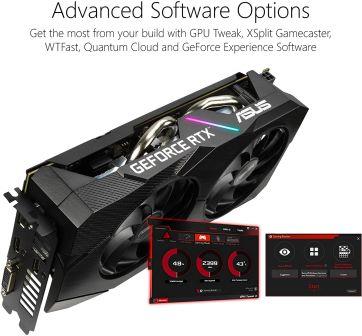
RTX 2060
The NVIDIA Turing cards are still some of the best on the market today and many consider them to be some of the most influential GPUs.
The RTX 2060 has a base clock speed of 1365 MHz. It also comes with the boost clock speed of 1680 MHz. This specification allows it delivering up to 6 GigaRays per second of ray tracing performance. It also has 1920 CUDA cores and 6GB of GDDR6 memory, which allows it to handle a wide range of graphics-intensive tasks, including gaming, video editing, and 3D rendering.
GTX 1080
It uses the Pascal processing unit, the most advanced gaming processor created so far. The GTX 1080 has a base clock speed of 1607 MHz. it has a boost clock speed of 1733 MHz, and it is equipped with 2560 CUDA cores and 8GB of GDDR5 memory. This Specifications helps it to handle demanding workloads and deliver smooth, high-definition graphics.
The Winner Is- A Tie
Interface
The interface refers to how your graphics card connects to other parts of your device. We looked at the graphics card and hardware interface.
RTX 2060
The graphics card interface is PCI Express x16. The PCI Express 4.0 is twice as fast as its previous version.
GTX 1080
There is no information about the graphics card interface. For the hardware interface, you have PCI Express 3.0
The Winner Is- The RTX 2060
Memory
High-performance games that use large amounts of data require large memories so that the image data can be constructed.
RTX 2060
The memory of this graphics card is 6GB GDDR6.
GTX 1080
The memory is slightly larger at 8192MB. As the memory is GDDRX5, the speeds might be a fraction slower, but it uses less power too.
The Winner Is- The GTX 1080
Performance Features
Aside from the GPU, interface, and memory, there are some other features that will help boost performance.
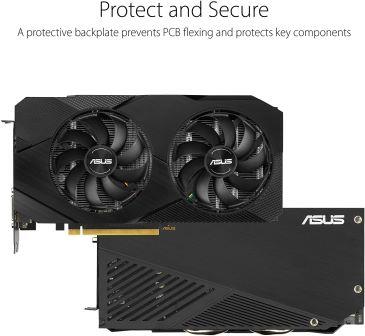
RTX 2060
It comes with 1920 CUDA cores for running lots of calculations at the same time. 120 texture mapping units, able to resize, rotate and distort bitmap images. And 48 ROPS, used for the final stage of the rendering process.
GTX 1080
The only information available is that it has 2560 CUDA cores.
The Winner Is- The RTX 2060
Connections
You can use both the graphics cards with multiple monitors.
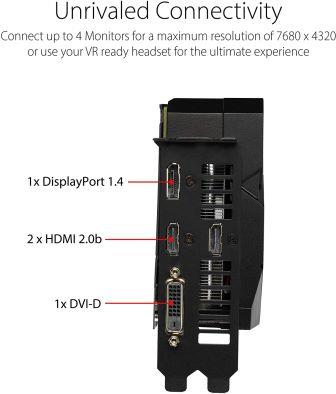
RTX 2060
There is a display port 1.4, 2 HDMI 2.0b connections, and a DVI-D port.
GTX 1080
The only difference is that instead of the DVI-D there is a dual-link DVI.
The Winner Is- The GTX 1080
Overclocking
Overclocking gives you the chance to run your computer at faster speeds than it was designed for. This clearly shows how powerful is your GPU hardware when under stress for giving maximum performance. it is important to understand these numbers. This can be done using software tools/apps or through the BIOS or UEFI settings of the computer.
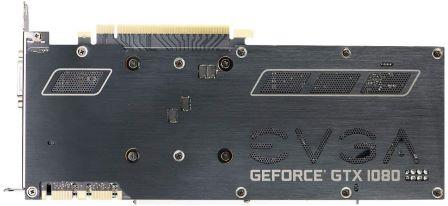
RTX 2060
When overclocking, the boost clock is 1785MHZ.
GTX 1080
The boost clock is a fraction less at 1733MHZ.
The Winner Is- The RTX 2060
Software
One of these graphics cards comes with software that helps to take full advantage of the card.
RTX 2060
It comes with GPU Tweak II, with simple mode, gaming booster, and professional mode. It comes with following software applications
- Real-time ray tracing : It creates realistic lighting and shadows in 3D graphics. This can be used to enhance the visual quality of 2D-3D games, movies, and other types of Media content.
- AI-accelerated rendering : This specific software enhance the rendering process and allow for more realistic and detailed graphics.
- NVIDIA GameWorks: The RTX 2060 graphic card is compatible with Nvidia Gameworks which is set of tools and architecture techniques which again improves the visual quality of games or movies. This also includes Ansel, which allows you to capture high-resolution photos/screenshots , and G-Sync, which helps to reduce screen tearing and stuttering effect.
- NVIDIA Studio: This enhance the performance of creative applications. it comes with tools like AI-accelerated video editing and 3D rendering, which can speed up the creative process and allow for more detailed and realistic graphics.
GTX 1080
Apart from Nvidia Gameworks and Nvidia studio tools and software which are mentioned above it comes with below 2 software components .
- Virtual Reality (VR): The GTX 1080 is designed to deliver a high-quality VR experience, it supports for Oculus Rift, HTC Vive, and other VR headsets. It provides a high frame rate and low latency, which can help to reduce motion sickness and improve the overall VR experience.
- OpenGL: The GTX 1080 is compatible with the OpenGL graphics API, which is used to create 3D graphics for a wide range of applications, including games, creative software, and scientific simulations.
The Winner Is- The RTX 2060
Technology
NVIDIA has been sure to include some of the latest technology to enhance the performance.
RTX 2060
Auto-Extreme removes harmful chemicals in the manufacturing process. This means that the cooling process is increased, with better power efficiency, and a longer life span.
GTX 1080
There is a wider range of technologies with NVIDIA Ansel. It is also ready for SLI HB Bridge, G-sync, and GameStream.
The Winner Is- The GTX 1080
Cooling
With all this power, the cards need to have a cooling system to prevent overheating. Both of these graphics processing unit (GPU) that is designed to generate a lot of heat when it is being used for demanding tasks, such as gaming or video editing. To prevent the GPU from overheating and ensure that it is running at optimal performance, it is equipped with a cooling system.

RTX 2060
It comes with IP5X dust-resistant wing-blade fans. It supports following cooling functions
- Air cooling: This is the most common type of cooling system used in the RTX 2060. It consists of a metal cooler shroud that covers the Graphic processing unit , and a heatsink that is attached to the RTX 2060. Air is drawn in through the cooler shroud and passes over the heatsink, which helps to dissipate heat. The heated air is then expelled out of the case through a vent or fan.
- Liquid cooling: Some models of the RTX 2060 are equipped with a liquid cooling system, which uses a closed loop of water to cool the GPU. The water is pumped through a radiator and cooled by a fan, and then passed over the GPU to dissipate heat. The cooled water is then returned to the radiator to be cooled again.
- Hybrid cooling: Some models of the RTX 2060 are equipped with a hybrid cooling system, which combines air cooling and liquid cooling. The GPU is cooled by a combination of air and water, which helps to increase the overall cooling performance.
GTX 1080
It has vapor chamber cooling technology. Which supports same Cooling functions as RTX 2060 which includes Air cooling , liquid cooling and hybrid cooling.
read more about other graphics cards here.
The Winner Is- A Tie
Pros and Cons for RTX 2060 vs GTX 1080
We have a few pros and cons of the RTX 2060 and the GTX 1080 before the final verdict.
RTX 2060
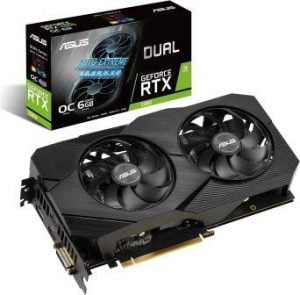
Pros:
- Nice silent fans
- Great clock speeds
- Overall, a consistently excellent performance
Cons:
- There might be a clicking sound at higher speeds
GTX 1080
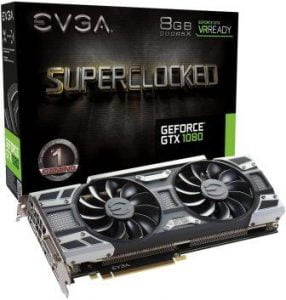
Pros:
- It’s a very good choice for VR
- Installation is easy
- Smooth game playing
Cons:
- Generally speaking, it’s more expensive
The Final Verdict
It was a difficult choice but, in the end, we chose the NVIDIA GeForce RTX 2060. This is because it was slightly better value for money but more importantly, the performance is superior. Gaming was smooth with high-quality graphics, it runs quietly, and over the long run, it is more reliable.
